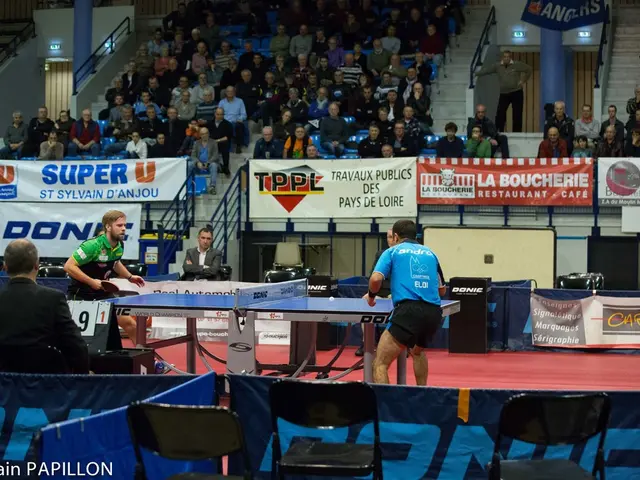Uncovering details: Exploring the ins and outs of the subject at hand
Poker value betting is all about betting with the best hand, aiming to make your opponents pay you off with their inferior holdings. This essential strategy requires mastering when and how to make a value bet, as well as adjusting to different players and scenarios.
Whether you're new to poker or a seasoned pro, this guide provides valuable tips on value betting. We cover crucial aspects such as identifying the right moments to value bet, sizing your bets, adjusting to various player types, and more.
What is Poker Value Betting?
Value betting, in poker terms, refers to making a bet when you have the best hand and wanting to get your opponents to call with their weaker hands. You want to make bets that provide the illusion of a good call for opponents, making them pay you off for your strong hand.
Building a successful value betting strategy takes time and practice but is vital for any serious poker player. A well-designed value bet neither under nor overestimates the bet size—it aims to strike the sweet spot for a profitable play.
Value betting starts as early as preflop and reaches its peak on the turn and river, when the pot is substantial, offering more potential for payouts. Consider a situation where you have three Aces on a board devoid of any straight or flush options on the river: You want to make a value bet, adjusting the bet size based on the pot and your opponents' potential holdings.
How Does Value Betting Differ from Bluffing?
While both techniques are crucial to poker Success, they serve different purposes:
- Value Bets: Designed to get called by your opponents, with the intent of making a profit from their inferior hands.
- Bluff Bets: Intended to trick opponents into folding their cards, even when you have a weaker hand.
Bluffing is often more effective when you hold drawing hands, like a flush or straight draw, as these hands can potentially improve if called. On the river, you should bluff on cards that significantly change the board structure, making it more likely for you to be the best hand.
Types of Value Bets
Not all value bets are cut from the same cloth! It's useful to categorize value bets by their obviousness and how hard they are to spot:
- Clear Value Bets: Easily identifiable as the best possible hand, and playable due to the sheer strength of the hand alone.
- Thin Value Bets: Sneakier, made with weaker hands that are still likely to be best based on the board texture and players involved. These require more finesse and skill to pull off.
For example, holding A♥K♦ on an unpaired board with three diamonds would be a clear value bet, as your hand is the nuts. Tackling a thin value bet would involve holding a hand like A♠7♠ on a board of 9♣7♦5♥3♣3♦. Although your second pair has a decent chance of being best, it takes a strong, experienced play to pull off a thin value bet in such situations.
Bet Sizing: Finding the Perfect Size for Value Bets
Bet sizing is often overlooked in value betting discussions, but it's an integral part of the strategy. Mastering this aspect of value betting can significantly improve your results, especially against weaker opponents.
Based on their size, value bets fall into three categories:
- Small Value Bets: Suitable when opponents can't have many weak hands to call with, like on boards where few draws are available.
- Large Value Bets: Helpful on later streets and in spots where opponents can have numerous strong draws and bluff-catchers.
- Overbets: Achieved when the bet size surpasses the pot. Deploy overbets against curious opponents who love to bluff-catch and make hero calls.
Adjust your value bet sizes based on the board's structure, opponent tendencies, and your own range. Generally, you should bet bigger on wet boards (boards with many connecting cards) and smaller on dry boards (boards with fewer connecting cards). Knowing your opponents' playing styles and adjusting your bets accordingly can unleash massive profits.
When to Value Bet for Maximum Value
Maximizing the value of your strong hands is critical to long-term profitability in poker. Identifying the perfect moments to value bet can sometimes be tricky, even for experienced players.
To decide if it's time to value bet, consider:
- Absolute Hand Strength: The most crucial factor—betting with strong hands should be your default approach.
- Your Entire Range: How high up in your range are you? If you have one of the best hands possible given the current situation, it's time to value bet.
- Your Opponent's Range: Is your opponent likely to connect with the board? What hands may they be hiding in their range that could call your value bet?
By comparing your range to your opponent's, you can estimate the likelihood you are ahead and the probability of getting called.
Using Value Betting Against Different Players
While certain value betting concepts always apply, much of poker's value betting comes down to understanding the players you face and their tendencies. Fine-tuning your value betting patterns to your opponents can lead to immense profits.
Consider adjusting your value betting patterns to capitalize on opponent's weaknesses:
- Loose-aggressive players: Make larger value bets when facing loose and splashy players, as they often call even with small bets.
- Tight-passive players: Tailor your value bets accordingly to tight and passive players, who are less likely to call big bets or chase draws.
Capitalize on opportunities to make small value bets and induce bluffs against aggressive players who love to bluff-catch. Your ability to read situations, assess opponents, and size your value bets accordingly is an invaluable skill.
Here are three real-life examples illustrating how you can apply value betting against various types of players:
Game Example 1
During a $1/$2 game with an effective stack of $200, you raise to $6 from the cutoff with 8♣8♦. The loose player in the big blind, who has been playing most hands, calls, and the flop comes J♦8♠4♣.
Your opponent checks, and you bet $5, taking the pot to $13. Given the dry board and your opponent's loose playstyle, you can bet full pot or even make an overbet of $30 and still expect to get paid quite often.
Game Example 2
In a $0.25/$0.50 online cash game, you open to $1.50 from UTG+1 with AsKs and get called by one player. The flop comes K♣9♦5♣, and your top pair greatly outranks your opponent's hand in most cases.
With $3.75 in the pot, many players might choose a bet of around $2 or $2.25, but deviating from the standardized bet size and going for maximum value could earn you more profits. Your opponent, usually lower-stakes players, often follow similar calling patterns for bets between $2, $3, or $3.50. Since your opponent calls regardless of bet size, you can go for close to the pot without fear.
Tips for Maximizing Your Value Bets in Poker
To get even more value from your poker value bets:
- Consider Your Opponent's Range: Analyze the hands your opponent can possibly have before making a value bet. Is your hand best given the board texture and their overall style?
- Adjust for Board Texture and Opponent Type: Adjust your bet sizes and frequencies based on the board and your opponents' playing styles.
- Be Cautious with Coordinated Boards: Proceed with caution when value betting on boards where straights and flushes are possible. Coordinated boards can shrink the value of your hand.
- Tread Carefully Around Loose Cannons: Be wary when playing against loose cannons—only value bet if you're willing to face aggressive action and call potentially larger bets.
- Extract Maximum Value: Value bet often and don't be afraid to go for value in marginal situations. Weak and passive opponents present excellent opportunities for value betting.
Conclusion
By carefully studying this guide, you now possess practical advice on betting for value in poker. From adjusting to player types and board textures to determining when and where value betting can be profitable, we've given you actionable strategies to enhance your game.
Remember that mastering poker's value betting takes time, so don't hesitate to try new things and learn from your mistakes. Happy betting!
FAQs
Question: What is poker value betting?Answer: Poker value betting refers to betting with the best hand, with the intent of making a profit by getting opponents to call their weaker hands.
Question: How does value betting differ from bluffing?Answer: Value betting aims to get called, while bluffing is intended to trick opponents into folding. Both strategies have distinct applications and roles in poker.
Question: What are thin value bets?Answer: Thin value bets are made with weaker hands that still hold substantial equity. These bets are more subtle and require a thorough understanding of board textures and opponent ranges.
Question: What should I consider when sizing value bets?Answer: When sizing value bets, take into account the board texture, your and your opponent's ranges, position, opponent tendencies, and stack sizes.
Question: What are polarized betting, block betting, and stack size considerations in value betting?Answer: Polarized betting involves making larger bets with strong hands or bluffs. Block betting employs small bets to control the pot size and gain information at a low cost. Stack size consideration involves factoring the stacks of both you and your opponents when making value bets.
Question: Does the board texture impact value betting decisions?Answer: Yes! Adjust your bet sizing and frequency based on the board texture and potential drawing opportunities. For example, make larger bets on draw-heavy boards to protect your hand from chasing draws.
- Poker value betting revolves around leveraging a strong hand to make opponents pay off with their weaker ones, while a well-strategized value bet neither under- nor overestimates the bet size.
- Whether you're new to poker or a seasoned pro, mastering the art of value betting is crucial for any serious poker player as it forms the foundation of a robust poker strategy.
- Value betting strategies can be employed in various casino games such as poker, sports betting, and even casino games like blackjack and roulette.
- Learning the nuances of value betting will grant you an edge in both online and live poker games, turning occasional profit into long-term gains.
- Bluffing and value betting are complementary strategies in poker, but they serve different purposes: value betting intends to make profitable calls from opponents, while bluffing aims to induce folds from weaker hands.
- Effective value betting requires paying attention to the board texture and players' tendencies, allowing for the implementation of thin value bets, clear value bets, small value bets, large value bets, and overbets when appropriate.
- Adjusting your strategy to address the playing styles of various player types, such as loose and splashy players or tight and passive players, can reap massive rewards in value betting scenarios.




